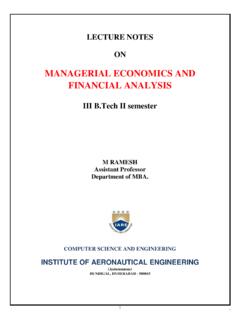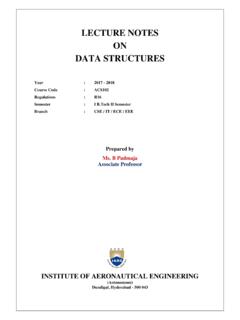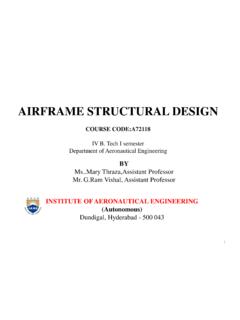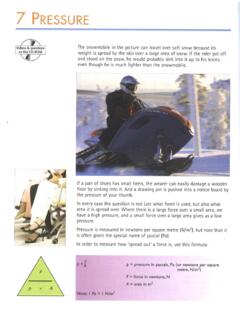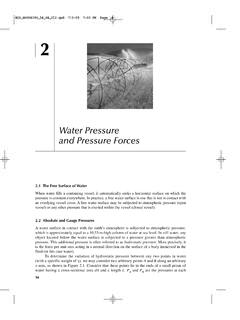Transcription of LECTURE NOTES - Institute of Aeronautical Engineering
1 1 LECTURE NOTES ON FLUID MECHANICS (ACE005) IV semester (Autonomous) (2018-19) Dr. G. Venkata Ramana Professor. DEPARTMENT OF CIVIL Engineering Institute OF Aeronautical Engineering (Autonomous) DUNDIGAL, HYDERABAD-500043 2 FLUID MECHANICS IV Semester: CE Course Code Category Hours / Week Credits Maximum Marks ACE005 Core L T P C CIA SEE Total 3 1 - 4 30 70 100 Contact Classes:45 Tutorial Classes:15 Practical Classes: Nil Total Classes: 60 OBJECTIVES: The course should enable the students to: I. Understand and study the effect of fluid properties on a flow system. II. Apply the concept of fluid pressure, its measurements and applications. III. Explore the static, kinematic and dynamic behavior of fluids. IV. Assess the fluid flow and flow parameters using measuring devices. UNIT-I PROPERTIES OF FLUIDS AND FLUID STATICS Classes: 09 Introduction : Dimensions and units Physical properties of fluids - specific gravity, viscosity, surface tension, vapor pressure and their influences on fluid motion, Pressure at a point, Pascal s law, Hydrostatic law - atmospheric, gauge and vacuum pressures.
2 Measurement of pressure, Pressure gauges, Manometers: Simple and differential U-tube Manometers. Hydrostatic Forces: Hydrostatic forces on submerged plane, horizontal, vertical, inclined and curved surfaces. Center of pressure, buoyancy, meta-centre, meta-centric height. Derivations and problems. UNIT-II FLUID KINEMATICS Classes: 09 Description of fluid flow, Stream line, path line and streak lines and stream tube. Classification of flows: Steady and unsteady, uniform and non-uniform, laminar and turbulent, rotational and irrotational flows. Equation of continuity for 1 - D, 2 - D, and 3 - D flows stream and velocity potential functions, flow net analysis. UNIT-III FLUID DYNAMICS Classes: 09 Euler s and Bernoulli s equations for flow along a streamline for 3 - D flow, Navier Stoke s equations (Explanationary), Momentum equation and its applications. Forces on pipe bend. Pitot-tube, Venturimeter and Orifice meter, classification of orifices, flow over rectangular, triangular, trapezoidal and stepped notches, Broad crested weirs.
3 UNIT-IV BOUNDARY LAYER THEORY Classes: 09 Approximate Solutions of Navier-Stoke s Equations, Boundary layer (BL) concepts, Prandtl contribution, Characteristics of boundary layer along a thin flat plate, Vonkarmen momentum integral equation, laminar and turbulent boundary layers (no deviation), BL in transition, separation of BL, control of BL, flow around submerged objects, Drag and Lift forces , Magnus effect. 3 UNIT-V CLOSED CONDUIT FLOW Classes: 09 Reynold s experiment Characteristics of Laminar & Turbulent flows. Flow between parallel plates, flow through long pipes, flow through inclined pipes. Laws of Fluid friction Darcy s equation, minor losses, pipes in series and pipes in parallel. Total energy line and hydraulic gradient line. Pipe network problems, variation of friction factor with Reynold s number Moody s chart, Water hammer effect. Text Books: 1. Modi and Seth, Fluid Mechanics , Standard book house, 2011.
4 2. & , Introduction to Fluid Machines , Tata Mc Graw Hill publishers Pvt. Ltd, 2010. 3. Potter, Mechanics of Fluids , Cengage Learning Pvt. Ltd., 2001. 4. Streeter and Wylie, Fluid Mechanics , McGraw Hill Book Co., 1979. 5. Rajput, A Text of Fluid Mechanics and Hydraulic Machines , S. Chand & company Pvt. Ltd, 6th Edition, 2015. Reference Books: 1. Shiv Kumar, Fluid Mechanics Basic Concepts & Principles , Ane Books Pvt Ltd., 2010. 2. White, Fluid Mechanics , Tata McGraw Hill Pvt. Ltd., 8th Edition, 2015. 3. Bansal , A text of Fluid Mechanics and Hydraulic Machines - Laxmi Publications (P) ltd., New Delhi, 2011. 4. D. Ramdurgaia, Fluid Mechanics and Machinery , New Age Publications, 2007. 5. Robert W. Fox, Philip J. Pritchard, Alan T. McDonald, Introduction to Fluid Mechanics , Student Edition Seventh, Wiley India Edition, 2011. Web References: 1. 2. 3. E-Text Books: 1. 2. 3. 4 UNIT I PROPERTIES OF FLUIDS AND FLUID STATICS Introduction to Fluid Mechanics Definition of a fluid A fluid is defined as a substance that deforms continuously under the action of a shear stress, however small magnitude present.
5 It means that a fluid deforms under very small shear stress, but a solid may not deform under that magnitude of the shear stress. By contrast a solid deforms when a constant shear stress is applied, but its deformation does not continue with increasing time. In , deformation pattern of a solid and a fluid under the action of constant shear force is illustrated. We explain in detail here deformation behaviour of a solid and a fluid under the action of a shear force. In , a shear force F is applied to the upper plate to which the solid has been bonded, a shear stress resulted by the force equals to , where A is the contact area of the upper plate. We know that in the case of the solid block the deformation is proportional to the shear stress t provided the elastic limit of the solid material is not exceeded. When a fluid is placed between the plates, the deformation of the fluid element is illustrated in We can observe the fact that the deformation of the fluid element continues to increase as long as the force is applied.
6 The fluid particles in direct contact with the plates move with the 5 same speed of the plates. This can be interpreted that there is no slip at the boundary. This fluid behavior has been verified in numerous experiments with various kinds of fluid and boundary material. In short, a fluid continues in motion under the application of a shear stress and can not sustain any shear stress when at rest. Fluid as a continuum In the definition of the fluid the molecular structure of the fluid was not mentioned. As we know the fluids are composed of molecules in constant motions. For a liquid, molecules are closely spaced compared with that of a gas. In most Engineering applications the average or macroscopic effects of a large number of molecules is considered. We thus do not concern about the behavior of individual molecules. The fluid is treated as an infinitely divisible substance, a continuum at which the properties of the fluid are considered as a continuous (smooth) function of the space variables and time.
7 To illustrate the concept of fluid as a continuum consider fluid density as a fluid property at a small region. Density is defined as mass of the fluid molecules per unit volume. Thus the mean density within the small region C could be equal to mass of fluid molecules per unit volume. When the small region C occupies space which is larger than the cube of molecular spacing, the number of the molecules will remain constant. This is the limiting volume above which the effect of molecular variations on fluid properties is negligible. 6 The density of the fluid is defined as Note that the limiting volume is about for all liquids and for gases at atmospheric temperature. Within the given limiting value, air at the standard condition has approximately molecules. It justifies in defining a nearly constant density in a region which is larger than the limiting volume. In conclusion, since most of the Engineering problems deal with fluids at a dimension which is larger than the limiting volume, the assumption of fluid as a continuum is valid.
8 For example the fluid density is defined as a function of space (for Cartesian coordinate system, x, y, and z) and time (t ) by . This simplification helps to use the differential calculus for solving fluid problems. Properties of fluid Some of the basic properties of fluids are discussed below- Density : As we stated earlier the density of a substance is its mass per unit volume. In fluid mechanic it is expressed in three different ways- Mass density r is the mass of the fluid per unit volume (given by ) Unit- Dimension- Typical values: water- 1000 kg/ Air- at standard pressure and temperature (STP) Specific weight, w: - As we express a mass M has a weight W=Mg . The specific weight of the fluid can be defined similarly as its weight per unit volume. Unit: Dimension: 7 Typical values; water- Air- (STP) Relative density (Specific gravity), S :- Specific gravity is the ratio of fluid density (specific weight) to the fluid density (specific weight) of a standard reference fluid.
9 For liquids water at is considered as standard fluid. Similarly for gases air at specific temperature and pressure is considered as a standard reference fluid. Units: pure number having no units. Dimension:- Typical vales : - Mercury- Water-1 Specific volume : - Specific volume of a fluid is mean volume per unit mass the reciprocal of mass density. Units:- Dimension: Typical values: - Water - Air- Viscosity 8 In section L1 definition of a fluid says that under the action of a shear stress a fluid continuously deforms, and the shear strain results with time due to the deformation. Viscosity is a fluid property, which determines the relationship between the fluid strain rate and the applied shear stress.
10 It can be noted that in fluid flows, shear strain rate is considered, not shear strain as commonly used in solid mechanics. Viscosity can be inferred as a quantative measure of a fluid's resistance to the flow. For example moving an object through air requires very less force compared to water. This means that air has low viscosity than water. Let us consider a fluid element placed between two infinite plates as shown in fig ( ). The upper plate moves at a constant velocity under the action of constant shear force . The shear stress, t is expressed as where, is the area of contact of the fluid element with the top plate. Under the action of shear force the fluid element is deformed from position ABCD at time t to position AB'C'D' at time ( ). The shear strain rate is given by Shear strain rate Where is the angular deformation From the geometry of the figure, we can define For small , Therefore, The limit of both side of the equality gives The above expression relates shear strain rate to velocity gradient along the y -axis.

